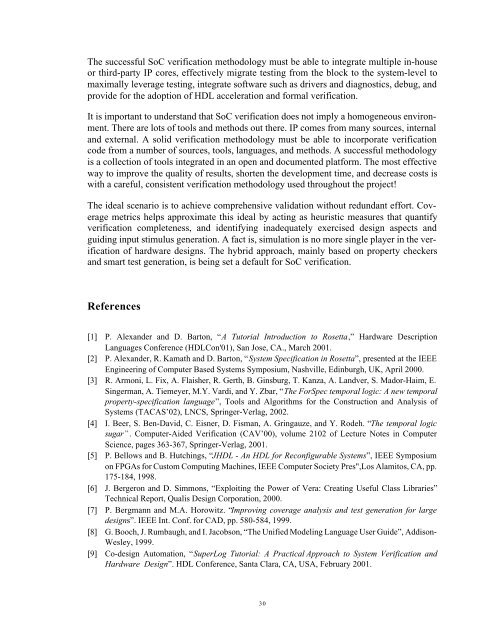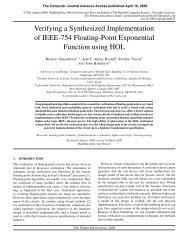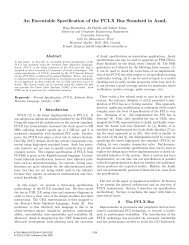PDF File - Hardware Verification Group - Concordia University
PDF File - Hardware Verification Group - Concordia University
PDF File - Hardware Verification Group - Concordia University
You also want an ePaper? Increase the reach of your titles
YUMPU automatically turns print PDFs into web optimized ePapers that Google loves.
The successful SoC verification methodology must be able to integrate multiple in-house<br />
or third-party IP cores, effectively migrate testing from the block to the system-level to<br />
maximally leverage testing, integrate software such as drivers and diagnostics, debug, and<br />
provide for the adoption of HDL acceleration and formal verification.<br />
It is important to understand that SoC verification does not imply a homogeneous environment.<br />
There are lots of tools and methods out there. IP comes from many sources, internal<br />
and external. A solid verification methodology must be able to incorporate verification<br />
code from a number of sources, tools, languages, and methods. A successful methodology<br />
is a collection of tools integrated in an open and documented platform. The most effective<br />
way to improve the quality of results, shorten the development time, and decrease costs is<br />
with a careful, consistent verification methodology used throughout the project!<br />
The ideal scenario is to achieve comprehensive validation without redundant effort. Coverage<br />
metrics helps approximate this ideal by acting as heuristic measures that quantify<br />
verification completeness, and identifying inadequately exercised design aspects and<br />
guiding input stimulus generation. A fact is, simulation is no more single player in the verification<br />
of hardware designs. The hybrid approach, mainly based on property checkers<br />
and smart test generation, is being set a default for SoC verification.<br />
References<br />
[1] P. Alexander and D. Barton, “A Tutorial Introduction to Rosetta,” <strong>Hardware</strong> Description<br />
Languages Conference (HDLCon'01), San Jose, CA., March 2001.<br />
[2] P. Alexander, R. Kamath and D. Barton, “System Specification in Rosetta”, presented at the IEEE<br />
Engineering of Computer Based Systems Symposium, Nashville, Edinburgh, UK, April 2000.<br />
[3] R. Armoni, L. Fix, A. Flaisher, R. Gerth, B. Ginsburg, T. Kanza, A. Landver, S. Mador-Haim, E.<br />
Singerman, A. Tiemeyer, M.Y. Vardi, and Y. Zbar, “The ForSpec temporal logic: A new temporal<br />
property-specification language”, Tools and Algorithms for the Construction and Analysis of<br />
Systems (TACAS’02), LNCS, Springer-Verlag, 2002.<br />
[4] I. Beer, S. Ben-David, C. Eisner, D. Fisman, A. Gringauze, and Y. Rodeh. “The temporal logic<br />
sugar” . Computer-Aided <strong>Verification</strong> (CAV’00), volume 2102 of Lecture Notes in Computer<br />
Science, pages 363-367, Springer-Verlag, 2001.<br />
[5] P. Bellows and B. Hutchings, “JHDL - An HDL for Reconfigurable Systems”, IEEE Symposium<br />
on FPGAs for Custom Computing Machines, IEEE Computer Society Pres",Los Alamitos, CA, pp.<br />
175-184, 1998.<br />
[6] J. Bergeron and D. Simmons, “Exploiting the Power of Vera: Creating Useful Class Libraries”<br />
Technical Report, Qualis Design Corporation, 2000.<br />
[7] P. Bergmann and M.A. Horowitz. “Improving coverage analysis and test generation for large<br />
designs”. IEEE Int. Conf. for CAD, pp. 580-584, 1999.<br />
[8] G. Booch, J. Rumbaugh, and I. Jacobson, “The Unified Modeling Language User Guide”, Addison-<br />
Wesley, 1999.<br />
[9] Co-design Automation, “SuperLog Tutorial: A Practical Approach to System <strong>Verification</strong> and<br />
<strong>Hardware</strong> Design”. HDL Conference, Santa Clara, CA, USA, February 2001.<br />
30





